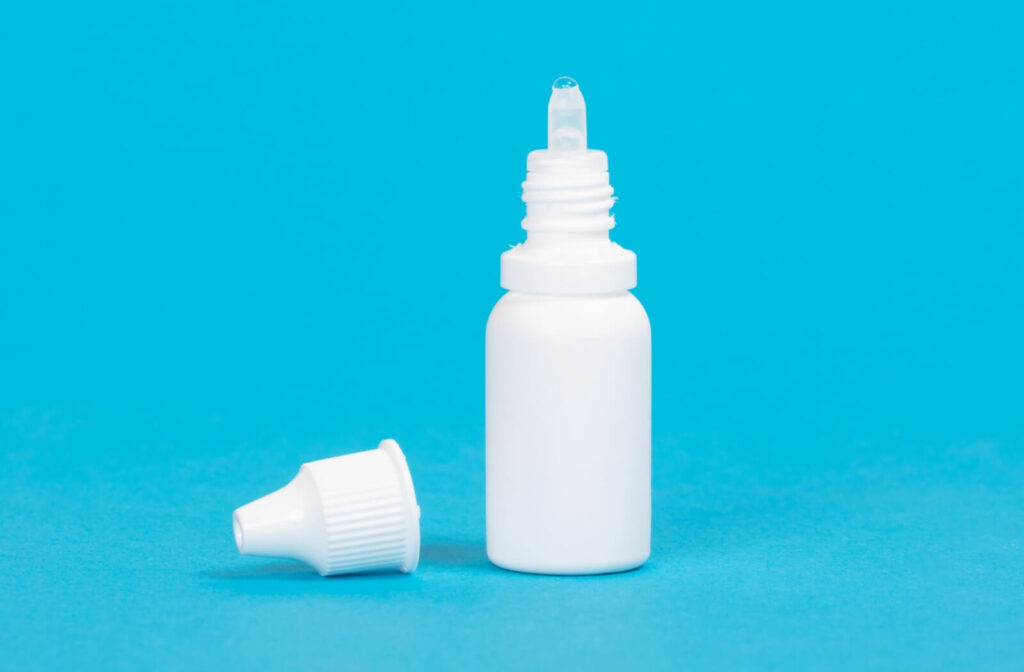Whether you’re at an eye exam, treating a medical condition, or trying to deal with dry eyes, you’ve likely used eye drops at some point before. There are all kinds of these drops; some are for allergies, some for treating conditions like glaucoma, and some are simply to help you find relief from irritation.
They’re an extremely efficient approach to treating all kinds of eye-related problems. However, while you can get some over-the-counter, these may not always be the most ideal solution. Sometimes, you need something a little more targeted—like optometrist-prescribed eye drops.
Are There Different Types of Eye Drops?
When it comes to eye drops, most people just imagine a generic bottle designed to prevent red eyes and dryness. But this isn’t the case. The drop and bottle is just the method of introducing a fluid to the eye.
Eye drops, like almost all other medications, come in plenty of different options. There are specific eye drops for:
- Dry eyes
- Allergies
- Dilating the pupils
- Medical conditions
Some drops have preservatives, making them a long-lasting solution you can keep on hand whenever you need to use them. Others are preservative-free, meaning that they tend to expire sooner; however, this also means that you can use them more often, as there are fewer chemicals to irritate the eyes.
Alongside this, there are also prescription and non-prescription options. You can acquire standard eye drops over the counter from most pharmacies. However, if you need more powerful or effective drops, you’ll need to visit your optometrist to discuss solutions.
Eye Drops for Dry Eyes
If you’ve ever dealt with dry, burning, and irritated eyes, you were likely dealing with dry eye—an extremely common eye condition caused by instability in your tear film.
Eye drops can be an excellent way to find relief from dry eyes. They can boost or supplement your natural tear production, helping protect your eyes and stave off irritation. These often come in non-prescription form, but you can get a prescription for specialty eye drops from your optometrist.
Eye Drops for Allergies
Seasonal allergies can be a pain. When your nose is running, you’re sneezing non-stop, and your eyes are watering, it’s perfectly natural to want relief.
This is when anti-allergy eye drops can help. There are several types of these drops, each of which can help you find relief. There are several primary types of these drops:
- Antihistamine drops designed to slow the body’s allergic reaction
- Decongestant drops designed to reduce redness and swelling
- Anti-inflammatory drops designed to reduce irritation, redness, and inflammation
- Mast cell stabilizing drops designed to prevent the release of allergic chemicals that cause symptoms
If you’re dealing with mild allergies that rarely flare up, you’ll likely be fine using standard over-the-counter drops from a local pharmacy. However, this isn’t always the case—some allergic reactions can be severe and start to impact your vision.
If you constantly find yourself battling with allergies that just won’t quit, visit your optometrist. They can help you find the right solution to your problems.
Eye Drops for Dilating Pupils
During an eye exam, your optometrist will likely need to check the back of your eyes. But this can be a problem sometimes—there’s an entire eyeball in the way! This is why they apply dilating eye drops.
These drops contain a low dosage of something called atropine. It temporarily relaxes the muscles in the eye, dilating your pupil to allow more light to enter. This makes it significantly easier to see through the physical structure of the eye so your optometrist can check the retina and optic nerve.
Dilating atropine eye drops are also sometimes used in coordination with myopia control methods. Because they relax the muscles in the eye, these can be particularly ideal for slowing how far myopia progresses.
While the effects of the atropine drops are still active, you’ll likely experience some degree of blurry vision and light sensitivity. Fortunately, these results are temporary; they’ll go away within a few hours.
Eye Drops for Medical Conditions
There is a wide range of eye conditions and diseases that require constant care to prevent symptoms from worsening. These drops can all vary depending on their purpose.
For example, if a person is diagnosed with glaucoma, they’ll be provided with a prescription for specialty eye drops designed to regulate their intraocular pressure. If a person has an eye infection, they’ll be prescribed antibiotic or antifungal drops to help fight the infection.
These drops should be treated like any other type of medicine. Make sure that you always follow your optometrist’s recommendations; stick to the schedule and dosage they recommend to ensure proper results.
FDA Warning About Eye Infection in Copycat Eye Drops
When it comes to eye drops, you should always discuss them with your optometrist before usage. Though many brands use similar solutions, they aren’t always 100% guaranteed to be safe; many knockoffs have been caught by the FDA over the years that can put you at risk.
While eye drops can be helpful, they can also easily cause significant damage to your eyes—especially when they aren’t inspected or regulated in any way. “Copycat” eye drops increase the risk of:
- Bacterial transmissions
- Eye infections
- Allergic reactions
- Damage to the cornea
- Vision issues
Don’t put your vision at risk; instead, make sure you’re only using drops recommended by your optometrist or another healthcare professional. Your vision is precious, so make a point to verify whether or not your drops are safe to use. If you’re ever unsure, reach out to your optometrist!
How to Use Eye Drops
- Wash your hands with water and soap to clean them before starting.
- Tilt your head back or lie down to prepare for eye drops.
- Hold the dropper properly, not too close or too far from the tip.
- Gently pull down your lower eyelid to ready your eye for the drop.
- Aim the dropper at the middle of your eye for precise application.
- Release the drop and blink a few times to spread it evenly.
- Close your eye for a few minutes to let it absorb the medicine, then reopen slowly.
Then, you should notice almost immediate results!
Do Eye Drops Expire?
Usually, eye drops last for some time, up to a year. This does depend on whether or not they have preservatives inside; drops with preservatives often last longer. It’s important to note that once the bottle is open, they’re less likely to stay completely sterile past the expiration date.
No matter what your eye drops are for, make sure you’re always checking this expiration date. You shouldn’t use eye drops after they’ve expired—this can lead to infections or other adverse reactions. It should be printed directly on the bottle or label. It isn’t worth putting your eyes at risk, so instead, make a point to see your optometrist to discuss replacements.
Talk to Our Team to Find Relief
Whether you need drops for dry eyes, a medical condition, allergies, or any other situation, our team at The Vision Place can help. We’re here to assess the situation and help you find relief! Don’t suffer from burning and irritated eyes—book an appointment with our team today.


